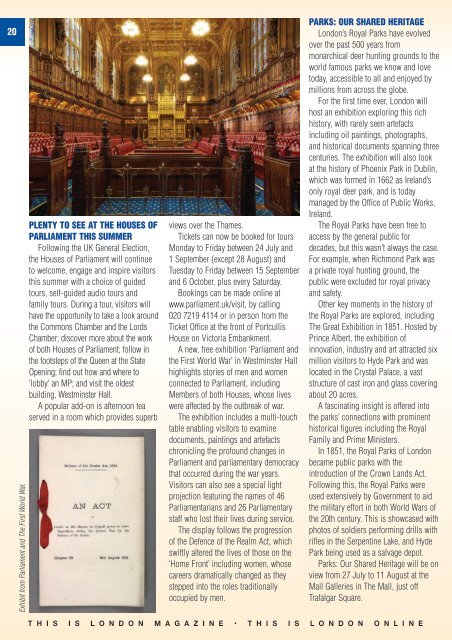TIL_Sommer_21-7-17
You also want an ePaper? Increase the reach of your titles
YUMPU automatically turns print PDFs into web optimized ePapers that Google loves.
20<br />
Exhibit from Parliament and The First World War.<br />
PLENTY TO SEE AT THE HOUSES OF<br />
PARLIAMENT THIS SUMMER<br />
Following the UK General Election,<br />
the Houses of Parliament will continue<br />
to welcome, engage and inspire visitors<br />
this summer with a choice of guided<br />
tours, self-guided audio tours and<br />
family tours. During a tour, visitors will<br />
have the opportunity to take a look around<br />
the Commons Chamber and the Lords<br />
Chamber; discover more about the work<br />
of both Houses of Parliament; follow in<br />
the footsteps of the Queen at the State<br />
Opening; find out how and where to<br />
'lobby' an MP; and visit the oldest<br />
building, Westminster Hall.<br />
A popular add-on is afternoon tea<br />
served in a room which provides superb<br />
views over the Thames.<br />
Tickets can now be booked for tours<br />
Monday to Friday between 24 July and<br />
1 September (except 28 August) and<br />
Tuesday to Friday between 15 September<br />
and 6 October, plus every Saturday.<br />
Bookings can be made online at<br />
www.parliament.uk/visit, by calling<br />
020 7<strong>21</strong>9 4114 or in person from the<br />
Ticket Office at the front of Portcullis<br />
House on Victoria Embankment.<br />
A new, free exhibition ‘Parliament and<br />
the First World War’ in Westminster Hall<br />
highlights stories of men and women<br />
connected to Parliament, including<br />
Members of both Houses, whose lives<br />
were affected by the outbreak of war.<br />
The exhibition includes a multi-touch<br />
table enabling visitors to examine<br />
documents, paintings and artefacts<br />
chronicling the profound changes in<br />
Parliament and parliamentary democracy<br />
that occurred during the war years.<br />
Visitors can also see a special light<br />
projection featuring the names of 46<br />
Parliamentarians and 26 Parliamentary<br />
staff who lost their lives during service.<br />
The display follows the progression<br />
of the Defence of the Realm Act, which<br />
swiftly altered the lives of those on the<br />
‘Home Front’ including women, whose<br />
careers dramatically changed as they<br />
stepped into the roles traditionally<br />
occupied by men.<br />
PARKS: OUR SHARED HERITAGE<br />
London’s Royal Parks have evolved<br />
over the past 500 years from<br />
monarchical deer hunting grounds to the<br />
world famous parks we know and love<br />
today, accessible to all and enjoyed by<br />
millions from across the globe.<br />
For the first time ever, London will<br />
host an exhibition exploring this rich<br />
history, with rarely seen artefacts<br />
including oil paintings, photographs,<br />
and historical documents spanning three<br />
centuries. The exhibition will also look<br />
at the history of Phoenix Park in Dublin,<br />
which was formed in 1662 as Ireland’s<br />
only royal deer park, and is today<br />
managed by the Office of Public Works,<br />
Ireland.<br />
The Royal Parks have been free to<br />
access by the general public for<br />
decades, but this wasn’t always the case.<br />
For example, when Richmond Park was<br />
a private royal hunting ground, the<br />
public were excluded for royal privacy<br />
and safety.<br />
Other key moments in the history of<br />
the Royal Parks are explored, including<br />
The Great Exhibition in 1851. Hosted by<br />
Prince Albert, the exhibition of<br />
innovation, industry and art attracted six<br />
million visitors to Hyde Park and was<br />
located in the Crystal Palace, a vast<br />
structure of cast iron and glass covering<br />
about 20 acres.<br />
A fascinating insight is offered into<br />
the parks’ connections with prominent<br />
historical figures including the Royal<br />
Family and Prime Ministers.<br />
In 1851, the Royal Parks of London<br />
became public parks with the<br />
introduction of the Crown Lands Act.<br />
Following this, the Royal Parks were<br />
used extensively by Government to aid<br />
the military effort in both World Wars of<br />
the 20th century. This is showcased with<br />
photos of soldiers performing drills with<br />
rifles in the Serpentine Lake, and Hyde<br />
Park being used as a salvage depot.<br />
Parks: Our Shared Heritage will be on<br />
view from 27 July to 11 August at the<br />
Mall Galleries in The Mall, just off<br />
Trafalgar Square.<br />
t h i s i s l o n d o n m a g a z i n e • t h i s i s l o n d o n o n l i n e

















